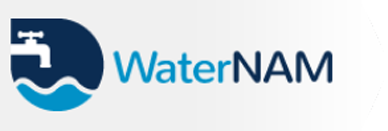Hydraulic Capabilities
WaterNAM’s extended period hydraulic analysis capabilities include:
- Simulation of distribution network of any size
- Calculation of friction head loss applying the Hazen-Williams, the Darcy Weisbach, or the Chezy-Manning equation
- Account for minor head losses at bends, fittings, etc.
- Model constant or variable speed pumps
- Compute pumping energy and cost
- Model operational behavior with various types of valves, including shutoff, check, pressure regulating, and flow control
- Model storage tanks with varying shapes (i.e., surface area can vary with height)
- Account for multiple demand categories at nodes, each with its own pattern of time variation
- Model pressure-dependent flow and flow from emitter nodes
- Allows system regulations such as rule based or logical controls on pump scheduling or tank-operations
Water Quality Analysis Options
WaterNAM is equipped with a powerful water quality analyzer which can:
- Model the movement of a non-reactive tracer material through the network over time
- Model the movement and fate of a reactive material as it grows (e.g., a disinfection by-product) or decays (e.g., chlorine residual) over time
- Model the age of water throughout a network (water age analysis)
- Track the percent of flow from a given node reaching all other nodes over time (trace analysis)
- Model reactions in the bulk flow and at the pipe wall
- Allow growth or decay reactions to proceed up to a limiting concentration
- Employ global reaction rate coefficients that can be modified on a pipe-by-pipe basis
- Allow for time-varying concentration or mass inputs at any location in the network
- Model storage tanks as being complete mix, plug flow, or two-compartment reactors
- Project GeodatabaseWaterNAM manages model data in a standard ArcGIS® geodatabase. It allows users to maintain model element (e.g. junctions, pipes, valves) data in individual layers in the geodatabase, while the non-visual information and general project setting options are stored in a set of predefined tables in the project geodatabase. Thus, WaterNAM provides a comprehensive framework for water utility management.
- Object-tree Panel for Model Data InterfaceWaterNAM runs in ArcGIS® 10.x (ArcMap™ 10.x) platform. It adds a tool bar and a comprehensive tree-structured model interface in ArcMap™. The simulation options, model objects and operational settings are organized in easy-to-use rows in a tree panel, and the panel provides the utmost flexibility in editing model data.
- Drag-and-Drop Model BuilderThe drag-and-drop model builder in WaterNAM enables users to efficiently create a water distribution model using existing GIS layers of the network components. Since network information are often readily available in GIS format and can be imported from CAD files, the drag-and-drop model builder extracts necessary information directly from the GIS data sources to quickly develop a water distribution model for hydraulic analyses or design.
- Network Analysis ToolThe Network Analysis Tool in WaterNAM identifies the discontinuities or irregularities in the existing node and link layers of a water distribution model. It enables a user to quickly find the type and extent of data anomalies, view them in comprehensive groups, and correct network errors before running a simulation.
- Rule Based Control EditorWaterNAM allows users to set logical controls on the operational devices (e.g. pumps, valves) in a straightforward way. The control editor provides options for either a single or a combination of operational conditions under each rule.
Advanced Attribute Editing and Management
WaterNAM introduces some special features to edit and manage project information such as:
- Viewing and editing of element properties in tables (i.e. grid view)
- Accessing all editing options and tools of ArcMap™ 10.x (including symbology and styles)
- Previewing input file for model simulation using the Project Details Report
- Setting desired numeric precision for the hydraulic parameters
- Importing curve data from text files or spreadsheets
Model Result Presentation
In WaterNAM the simulation results are presented in a number of ways including:
- Detailed simulation status report with convergence error
- Time series output of hydraulic and water quality variables (charts and tables)
- Time series comparison between two analysis variables (charts)
- Profile plot of analysis variables along a defined pipe line (elevation view)
- Reaction summary report (pie-chart)
- Energy-cost report (table)
- Result table for the analysis variables
EPANET Compatibility
WaterNAM is fully compatible with EPANET, which is freely available from USEPA. Its wide range of applications and long history make it a very reliable software for analysis and design of water distribution systems. WaterNAM integrates the hydraulic engine of EPANET in ArcMap™ 10.x and it can:
- Export a WaterNAM project to an EPANET model network file (.inp file)
- Export a WaterNAM project to an EPANET model scenario file (.scn file)

